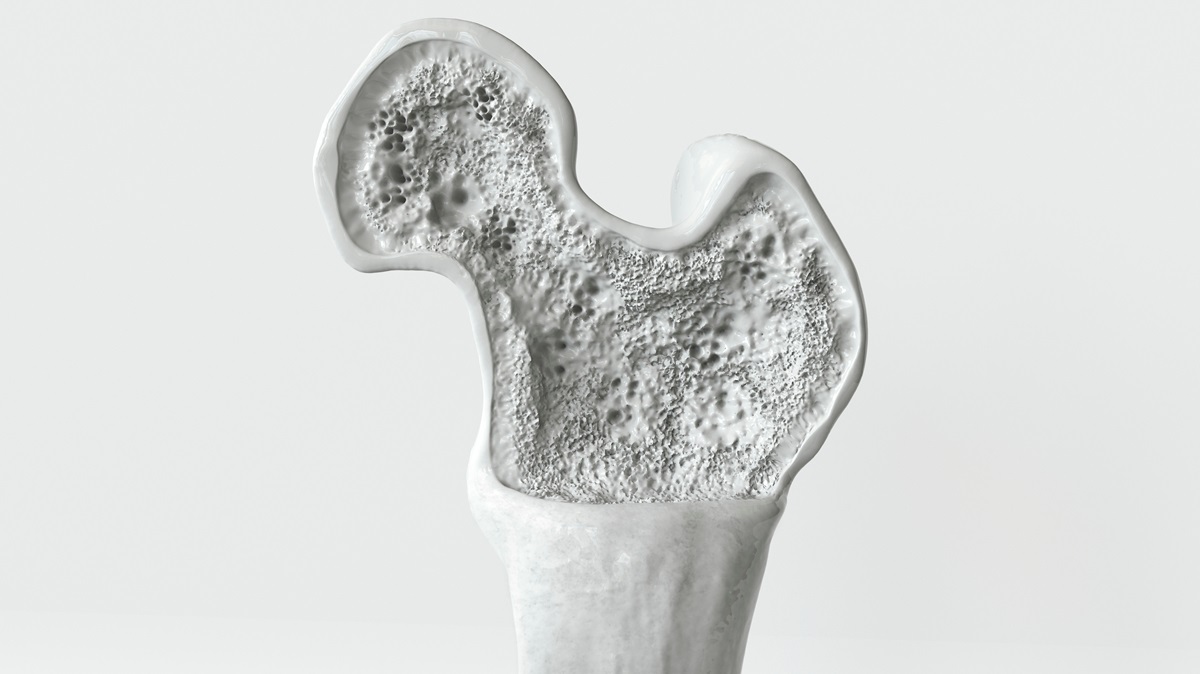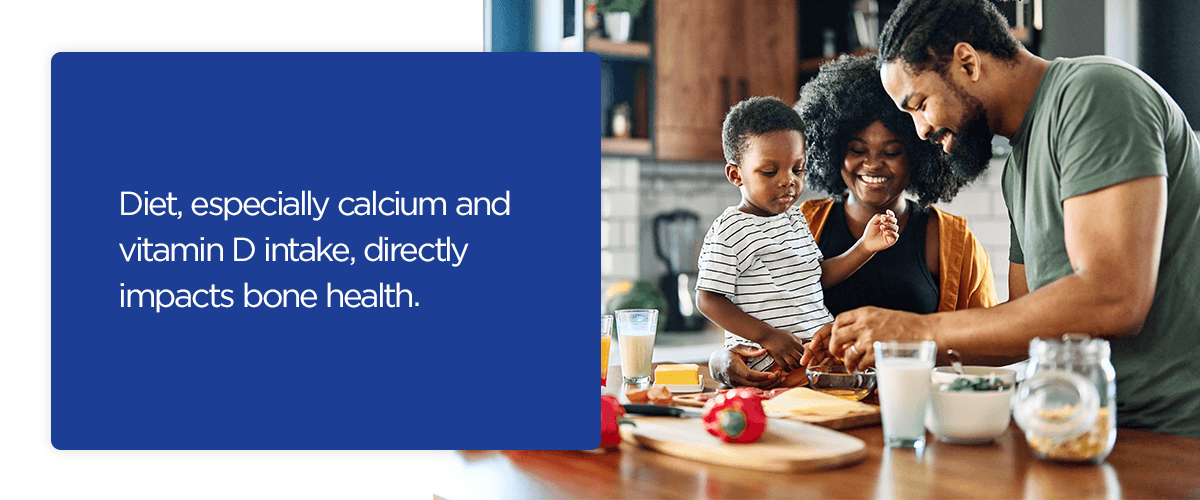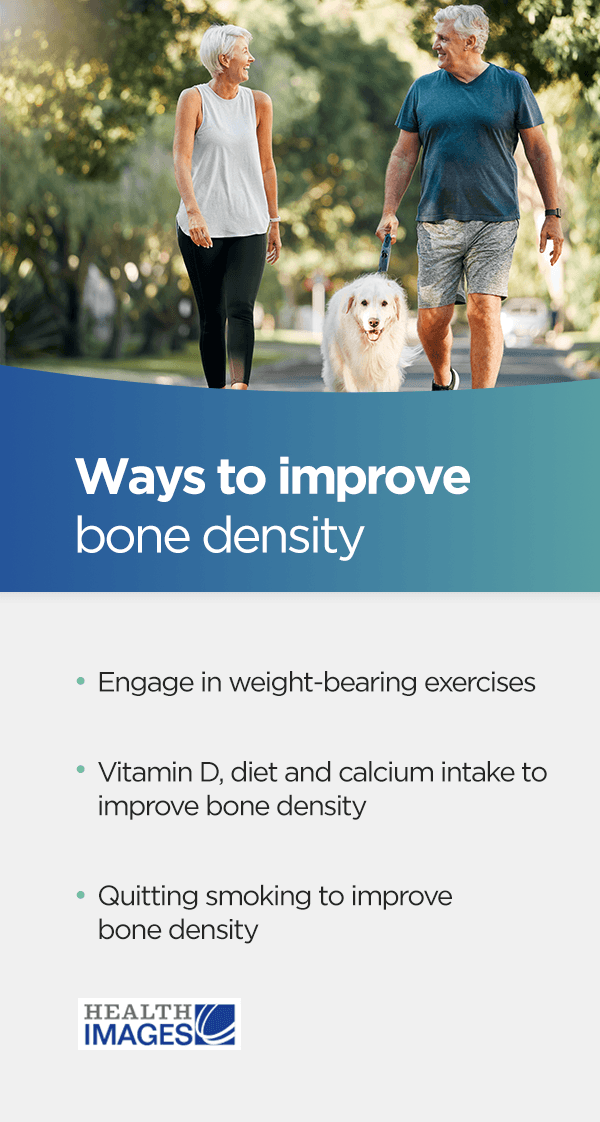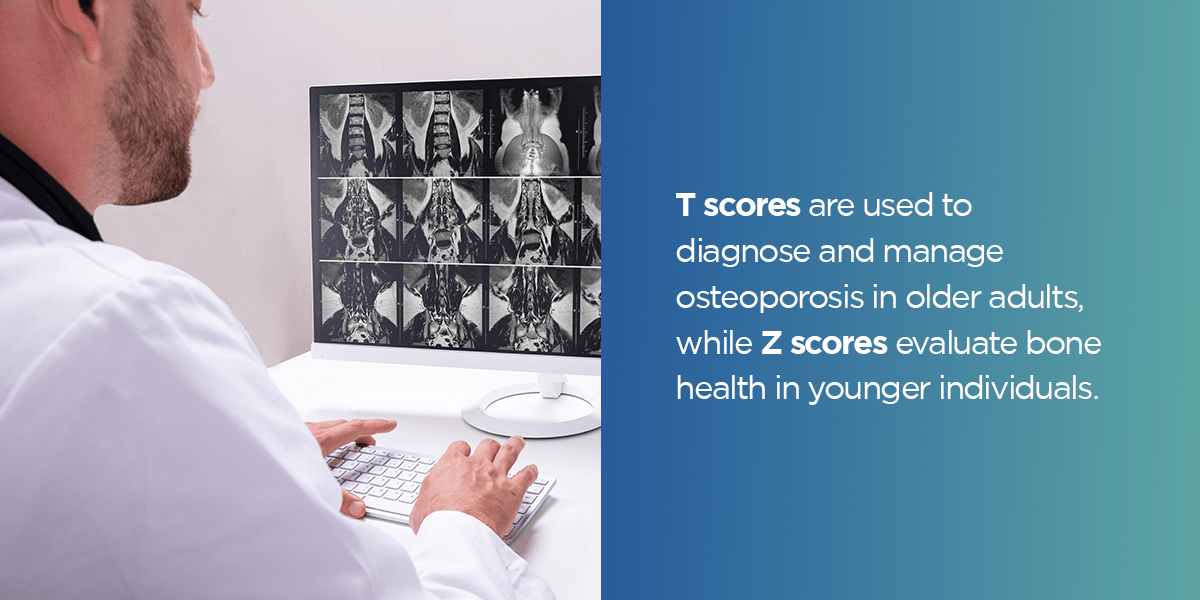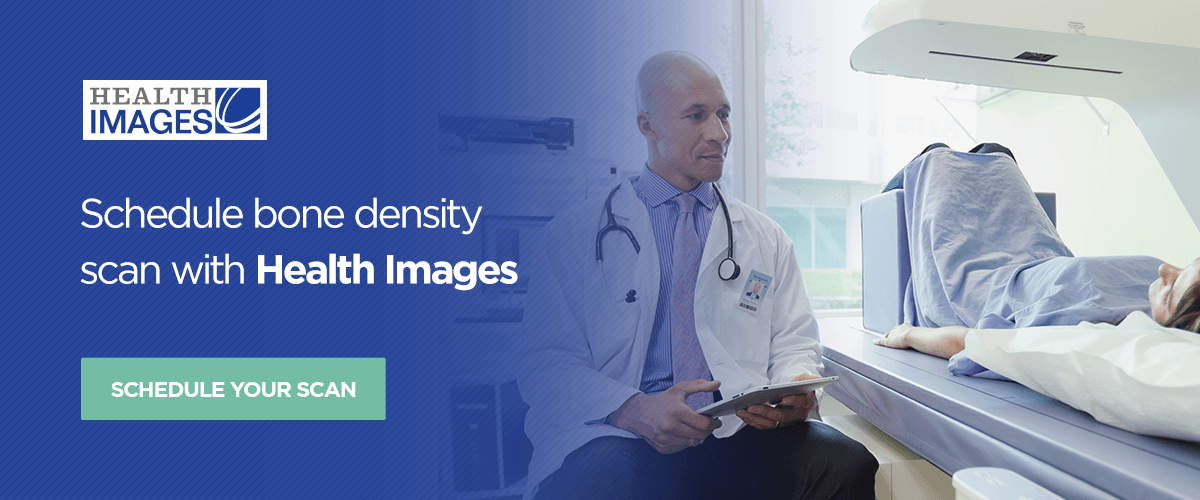Can Bone Density Be Improved?
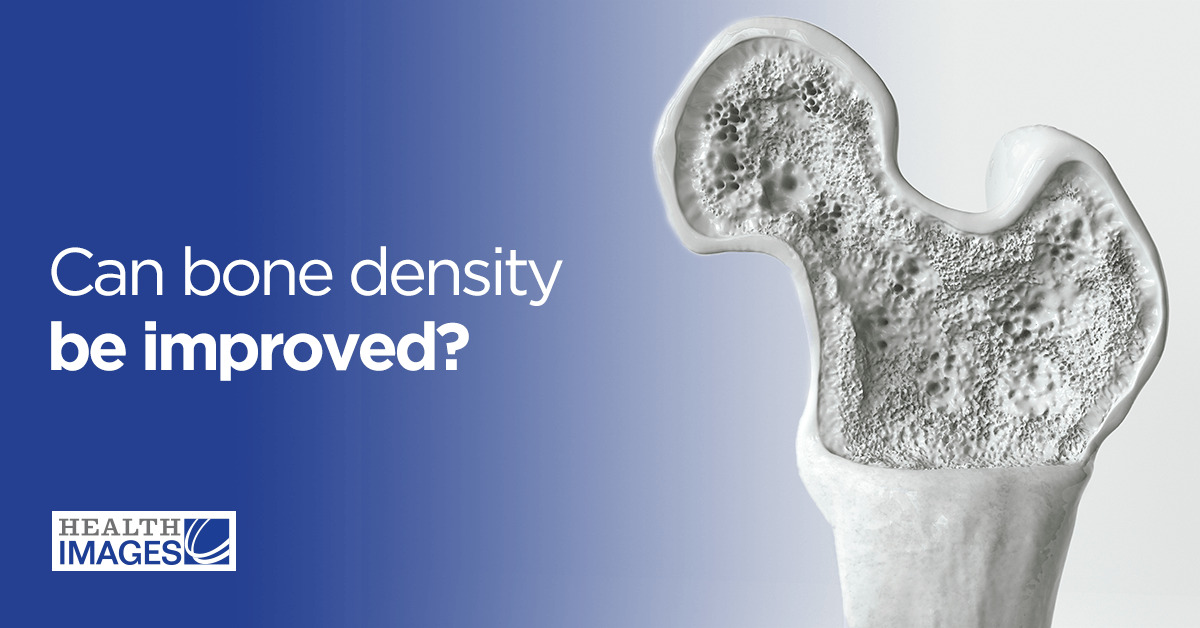
Bone density measures bone strength and mineral content, which determines our susceptibility to fractures and conditions. Diseases around bone density, such as osteoporosis, are responsible for over 2 million broken bones every year. Improving bone density is a long-term process, but it can be achieved.
Individual factors like age, overall health and underlying medical conditions may influence your efforts’ effectiveness. Be gentle and patient, as bone density takes a while to turn around and improve. Consult with a healthcare provider for personalized guidance and to create realistic goals for what is possible.
Jump to Sections:
- The basics of bone density
- Can bone density be improved?
- Ways to improve bone density
- Bone density tests
- Schedule bone density scan with Health Images
The basics of bone density
Bone density refers to the measure of mineral content within bone tissue. It is an indicator of bone health, as it directly affects the bone’s strength and ability to withstand stress. The denser your bones, the stronger they are, reducing the risk of fractures and developing conditions such as osteoporosis.
The role of osteoporosis
Osteoporosis is characterized by a progressive loss of bone density and deterioration of bone tissue. While bone remodeling is a natural and continuous process, osteoporosis disrupts this balance by causing a breakdown of old bone tissue, outpacing the formation of new bone. As a result, bones become porous, brittle and highly susceptible to fractures.
Common sites for fractures in individuals with osteoporosis include the hip, spine and wrist. Hip fractures, in particular, are associated with significant morbidity and mortality, making them a major concern for those affected by this condition. It is often referred to as a “silent disease” because it progresses stealthily, often without noticeable symptoms, until a fracture occurs.
Understanding bone remodeling
Our bones are not static structures but dynamic tissues continuously undergoing a resorption and formation cycle. Old bone tissue is broken down by specialized cells called osteoclasts, while new bone is synthesized by osteoblasts.
Osteoclasts are responsible for bone resorption. Bone resorption is breaking down and eliminating old or damaged bone tissue. It accomplishes this task by releasing enzymes and acids which dissolve the mineralized bone matrix. The enzymes also release calcium and other minerals into the bloodstream. This mechanism maintains proper calcium levels within the body and expedites the removal of damaged bone.
Osteoblasts secrete collagen and other essential proteins, constructing a supportive framework for depositing new bone minerals. Osteoblasts also have a regulatory role in managing the activity of osteoclasts, ensuring a delicate balance between bone resorption and formation.
Factors affecting bone density
Genetics plays a role in determining your baseline bone density. At the same time, diet, especially calcium and vitamin D intake, directly impacts bone health. Several factors influence bone density, including diet, physical activity and hormonal balance:
- Calcium and Vitamin D: Vitamin D deficiency impairs the body from calcium absorption. You need calcium, as it serves as a building block for bones.
- Exercises: Resistance training places mechanical stress on the bones. The stress causes the bones to become denser and stimulates osteoblast activity. Other exercises to include are walking, running, dancing and weightlifting.
- Estrogen and testosterone: Reduced estrogen levels during menopause can accelerate bone loss, rendering post-menopausal women more vulnerable to osteoporosis. On the other spectrum, men with low testosterone levels also face an elevated risk of bone loss and fractures.
- Thyroid hormones: Excessive or insufficient thyroid hormone can result in bone loss and negatively impact bone density.
Other bone density medical conditions
Several medical conditions and factors can affect bone density and health beyond osteoporosis. Other conditions include:
- Osteopenia: Osteopenia is a condition characterized by lower-than-normal bone density, but it’s not as severe as osteoporosis. It’s often considered a precursor to osteoporosis and indicates a higher risk of developing the more severe bone loss condition.
- Hyperparathyroidism: This condition occurs when the parathyroid glands produce excessive parathyroid hormone, leading to increased bone resorption and decreased bone density.
- Celiac disease: Celiac disease can lead to nutrient malabsorption, including calcium and vitamin D, which are vital for bone health. Malabsorption can result in reduced bone density.
- Rheumatoid arthritis: Chronic inflammation associated with rheumatoid arthritis can negatively impact bone health, leading to decreased bone density and an increased risk of fractures.
- Multiple myeloma: This type of cancer affects plasma cells in the bone marrow. It can weaken bones, leading to fractures and bone pain.
Can bone density be improved?
The health of our bones is not a fixed destiny determined solely by genetics. Instead, there are steps we can take to actively manage and help improve our bone density over time. While age-related bone loss is a natural part of aging, several strategies and interventions can help maintain and even enhance bone density.
Ways to improve bone density
There are a number of ways you can consider to enhance bone density:
Engage in weight-bearing exercises
Activities that involve bearing your body weight stimulate bone growth. These exercises involve working against gravity while on your feet, which stresses your bones and makes them stronger and denser. Here are a few benefits to encourage you:
- Stimulate bone growth: Weight-bearing exercises create mechanical stress on bones, prompting them to adapt and become denser. This stress encourages bone-forming cells (osteoblasts) to become more active, leading to the deposition of minerals like calcium and phosphorus in the bone matrix.
- Prevent bone loss: Bone loss is a natural process as we age. Weight-bearing exercises can slow this process and help maintain bone density over time, reducing the risk of osteoporosis and fractures.
To take advantage of the above benefits, consider incorporating the following types of weight-bearing exercises:
- Aerobic activities: These exercises raise your heart rate and involve repetitive, weight-bearing movements. Examples include walking, jogging, running, dancing and stair climbing.
- Strength training: Resistance exercises using weights, resistance bands or your own body weight can effectively strengthen bones. Focus on major muscle groups with squats, lunges, push-ups and weightlifting exercises.
- Sports: Many sports, such as tennis, basketball and soccer, involve weight-bearing movements due to running, jumping and quick changes in direction.
- Hiking: Hiking on uneven terrain and uphill slopes adds an extra challenge to your bones. Plus, it offers the added benefit of spending time outdoors.
- Tai Chi and Yoga: These mind-body practices incorporate weight-bearing elements and are excellent for balance, flexibility and bone health.
Consult with your healthcare provider before initiating a new exercise program. Your exercise plan should incorporate attainable objectives that align with your existing fitness level and any limitations you may have. As your fitness progresses, you can gradually ramp up the intensity and duration of your workouts.
Vitamin D, diet and calcium intake to improve bone density
Maintaining adequate calcium and vitamin D levels through your diet will optimize bone health and improve bone density. Here’s a look at how they contribute to bone health and strategies to ensure you get enough of them, starting with Vitamin D:
- Calcium absorption: Without sufficient vitamin D, your body cannot effectively absorb calcium from the food you consume.
- Bone remodeling: Vitamin D also helps balance the activities of osteoblasts (bone-forming cells) and osteoclasts (bone-resorbing cells).
- Muscle function: Vitamin D is involved in muscle function, and strong muscles can support bone health by reducing the risk of falls and fractures.
Where can you get sources of Vitamin D? Here are a few places to start:
- Sunlight: Your body can produce vitamin D when your skin is exposed to sunlight.
- Diet: Fatty fish (e.g., salmon, mackerel and tuna), eggs and foods like fortified milk, orange juice and cereals are dietary sources of vitamin D.
A well-balanced diet that provides essential nutrients is essential for maintaining and improving bone density. Nutrients to focus on include:
- Calcium: Adequate calcium intake is crucial for bone mineralization. Dietary sources include dairy products (e.g., milk, yogurt and cheese), leafy greens (e.g., kale and collard greens), almonds and fortified foods.
- Vitamin K: Vitamin K is involved in bone mineralization and can be found in leafy greens (e.g., spinach, kale and broccoli) and vegetable oils.
- Magnesium: Magnesium contributes to bone structure and bone density. It is found in nuts, seeds, whole grains and leafy greens.
- Phosphorus: This mineral is abundant in foods like meat, poultry, fish, dairy products, nuts and whole grains.
- Protein: Adequate protein intake is essential for overall bone health, as it provides the building blocks for bone tissue. Include lean protein sources like lean meats, poultry, fish, beans and tofu in your diet.
- Vitamin D: Spend some time outdoors in the sunlight, particularly during the sunniest parts of the day, to support your body’s natural production of vitamin D. Remember to take precautions to prevent skin damage from excessive sun exposure.
Quitting smoking to improve bone density
When considering strategies to improve bone density, quitting smoking should be a top priority. Here’s how smoking affects bones and why quitting is a good idea:
- Reduced bone density: Smoking is associated with lower bone density, which increases the risk of fractures. Nicotine and other harmful chemicals in tobacco can interfere with the bone remodeling process, leading to weaker bones.
- Impaired calcium absorption: Smoking may hinder calcium absorption, a mineral for bone health, in the intestines.
- Hormonal imbalances: Smoking can disrupt hormone levels, including estrogen, which is protective in bone health, especially in women.
Another great idea is to limit alcohol intake for the following reasons:
- Bone loss: Alcohol interferes with bone remodeling and can disrupt the balance between bone formation and resorption.
- Nutrient depletion: Alcohol can interfere with absorbing essential nutrients like calcium, vitamin D and magnesium.
- Risk of falls: Alcohol impairs balance and coordination, increasing the risk of falls and fractures, particularly in older adults.
Bone density tests
Bone density tests, also known as bone densitometry or DXA scans (Dual-Energy x-ray Absorptiometry), are specialized medical imaging procedures used to assess bone health and measure bone density. These tests provide insightful information about the strength and density of your bones, which aids in diagnosing bone density conditions and assessing fracture risk. Two common measurements are used in bone density tests — T scores and Z scores.
T scores
T scores are the most widely used measurement in bone density testing. They compare your bone density to a healthy young adult of the same gender and give you insights if you need to start taking preventive measures or medication. Here’s how T scores work:
- Normal bone density: If your T score is above -1, it indicates that your bone density is within the normal range compared to a young adult of the same gender.
- Osteopenia (Low Bone Density): A T score between -1 and -2.5 suggests that you have lower bone density than a young adult but not low enough to be classified as osteoporosis. This condition is often referred to as osteopenia, indicating reduced bone mass.
- Osteoporosis: A T score of -2.5 or lower indicates that you might have osteoporosis. In this case, your bone density is significantly lower than that of a healthy young adult, putting you at a higher risk of fractures.
Z scores
Z scores are different from T scores, as T scores are used to diagnose and manage osteoporosis in older adults, while Z scores evaluate bone health in younger individuals, children or those with conditions that affect bone development. Here’s how Z scores work:
- Normal bone density: If your Z score is near zero, it suggests that your bone density is similar to what is expected for someone of your age, gender and, if applicable, ethnicity.
- Below-expected bone density: A Z score significantly below zero may indicate that your bone density is lower than expected for your age and gender, potentially warranting further investigation.
- Factors affecting Z scores: Z scores can be influenced by various factors, including medical conditions, medications and lifestyle. A Z score below -2 may be a cause for concern. It may lead to further evaluation to determine the underlying cause of reduced bone density.
Schedule bone density scan with Health Images
If your physician believes you are at risk of osteoporosis or if you have concerns about your bone health, it’s time to take action. Health Images, with centers in Denver, Boulder and surrounding areas, is your partner in high-quality imaging services and bone density testing. Our commitment to our communities ensures you have access to the latest medical imaging technology and expertise.
By scheduling a bone density test at one of our centers, you are taking a proactive step toward understanding and improving your bone density.

